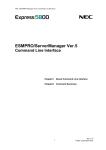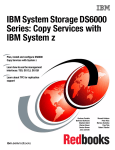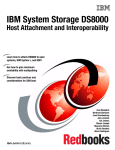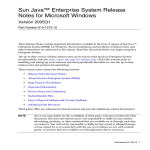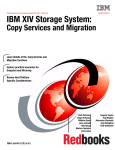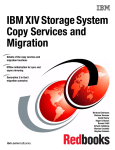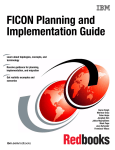Download Troubleshooting Performance Problems With DASD Array
Transcript
Troubleshooting Performance Problems With DASD Array Host Adapters By Steve Guendert, Ph.D. T he article “Performance Troubleshooting Using the FICON Director Activity Report” (March/April 2013 Enterprise Tech Journal available at http://entsys.me/ c000r) is the latest in a series of articles on System z I/O performance. As a quick review, this series has assumed there was an application Service Level Agreement (SLA)/ Service Level Objective (SLO) for transaction response time that wasn’t being met. Some basic root cause analysis was performed by checking the key RMF reports used in mainframe I/O performance management. The most recent article examined the RMF 74-7 record, the RMF FICON Director Activity Report, to determine if the FICON Storage Area Network (SAN) may have caused the performance issue. This article focuses on the DASD array host adapters (i.e., what connects the DASD array to the FICON director and to the System z channel). The section on DASD array hardware specifics focuses on IBM DS8000 series DASD arrays, specifically the DS8800 unless otherwise noted. Space limitations preclude going into the technical details on the EMC and HDS hardware equivalents, but the same basic principles of analysis and troubleshooting apply equally well to those and other DASD arrays that support FICON attachment to IBM System z. Figure 1 illustrates our environment and where the various I/O-related RMF reports fit. DASD Array Host Adapter Hardware The DS8800 supports two types of Host Adapters (HAs) installed in the array’s I/O enclosures: Fibre Channel/ FICON four-port and eight-port HA cards with a nominal port speed of 8 Gbps. Fibre Channel (FC) is a technology standard that allows data to be transferred from one node to B • E n t e r p r i s e T e c h J o u r n a l • J u n e / J u l y 2 0 E1n3t e r p r i s e T e c h J o u r n a l • J u n e / J u l y 2 0 1 3 another at high speeds and great distances. This information can include commands, controls, files, graphics, video and sound. FC connections are established between FC ports that reside in I/O devices, host systems and the network that interconnects them. The network consists of elements such as switches, bridges and repeaters that are used to interconnect the FC ports. Using the DS8800 long-wave fibre port HAs, connections are possible up to a 10 km (6.2 miles). That distance isn’t user-configurable; it depends on the type of HA and switch. All ports on each HA are the same type: long wave or short wave. The DS8800 uses FC to transmit Fibre Channel connection (FICON) traffic, which uses FC frames to carry System z I/Os. A Local Connector (LC) type cable connector is required to attach to this adapter. Each of the ports on a DS8800 HA can also independently be either FCP or FICON. You can change the port type by using the DS Storage Manager Graphical User Interface (GUI) or the DS8000 Command-Line Interface (DSCLI) commands. A port can’t be both FICON and FCP simultaneously, but can be changed as required. The HA card is a Peripheral Component Interconnect Express (PCIe) Gen 2 bus with a dual-core 1.5 GHz PowerPC processor (Freescale MPC8572). A new highfunction, high-performance, Application-Specific Integrated Circuit (ASIC) drives the card. Each FC port supports a maximum of 509 host login IDs and 1,280 paths so the user can create large FICON SANs. The front-end with the 8 Gbps ports scales up to 128 ports for a DS8800, using the eight-port HAs, which results in a theoretical aggregated host I/O bandwidth of 128 x 8 Gbps. The DS8800 8 Gbps host adapter ports can each negotiate to 8, 4 or 2 Gbps speeds (but not 1 Gbps). The eight-port HAs offer essentially the same total maximum throughput when taking loads of all its ports together as the four-port HAs of the DS8800. So, the eight-port HAs are meant for more attachment options, but not for more performance. Random, small-block performance is usually no issue when considering HA performance because this type of port can deliver up to 100K Input/Output Operations Per Second (IOPS) for a 4K (small-block) cachehit workload. With several HAs, potential IOPS figures from the HAs are far higher than the number of disk drives currently supported in a DS8800. FICON host channels limit the number of devices per channel to 16,384. To fully access 65,280 devices on a storage unit, it’s necessary to connect a minimum of four FICON host channels to the storage unit. You can access the devices through a switch to a single storage unit FICON port. With this method, you can expose 64 control-unit images (16,384 devices) to each host channel. In the System z environment, the normal practice is to provide multiple paths from each host to a disk subsystem (typically, four to eight paths are installed). The channels in each host that can access each Logical Control Unit (LCU) in the DS8800 are defined in the Hardware Configuration Definition (HCD) or I/O Configuration Data Set (IOCDS) for that host. Dynamic Path Selection (DPS) lets the channel subsystem select any available (non-busy) path to initiate an operation to the disk subsystem. Dynamic Path Reconnect (DPR) lets the DS8800 select any available path to a host to reconnect and resume a disconnected operation such as to transfer data after disconnection due to a cache miss. The channel subsystem on the host and the DS8800 manages these functions, which are part of the System z architecture. An availability-oriented approach applies to the System z environment: Plan enough host connections for each server so if half the connections fail, processing can continue at the level of performance before the failure. When using switches to connect multiple paths between servers and a DS8000, use a minimum of two separate FICON switching devices (dual-fabric design) to avoid a single point of failure. Most large installations use four or even eight fabrics. IBM also offers these guidelines for optimizing the performance of DS8800 HAs: •For FC and FICON paths with high utilization, don’t use more than four ports on a DS8800 8 Gbps HA, which might increase the number of HAs required. Avoid using all eight ports of the eight-port HA cards for demanding workloads because the performance of the HA card doesn’t scale with more than four ports. •Don’t use the same DS8800 I/O port for host attachment and copy services remote replication (such as Metro Mirror or Global Mirror). •Consider using separate HA cards for FICON protocol and FCP. Even though I/O ports on the same HA can be configured independently for the FCP and the FICON protocol, it’s preferable to isolate your z/OS environment (FICON) from your open systems environment (FCP). •Spread the paths from all host systems across the available I/O ports, HA cards and I/O enclosures to optimize workload distribution across the available resources, depending on your workload sharing and isolation considerations. •Spread the host paths that access the same set of volumes as evenly as possible across the available HA cards and I/O enclosures. This approach balances workload across hardware resources and helps ensure a hardware failure doesn’t result in a loss of access. •Ensure that each host system uses a multipathing device driver, such as Subsystem Device Driver (SDD), and a minimum of two host connections to different HA cards in different I/O enclosures on the DS8800. Preferably, evenly distribute them between left-side (even-numbered) I/O enclosures and right-side (odd-numbered) I/O enclosures for the highest availability and a balanced workload across I/O enclosures and HA cards. Monitoring for Potential HA Performance Problems Let’s assume you’ve followed these best practice recommendations, yet you still have a performance problem causing missed SLAs/SLOs. This section identifies some methods, tools and techniques you can use to determine whether the bottleneck could be one or more DASD array host adapter ports. We will briefly revisit the RMF 74-7 record (FICON Director Activity Report) and discuss some additional tools: the ESS Link Statistics component of the SMF 74-8 record, Brocade FabricWatch and Intellimagic Vision. E n t e r p r i s e T e c h J o u r n a l • J u n e / J u l y 2 0E1n 3t e r p r i s e T e c h J o u r n a l • J u n e / J u l y 2 0 1 3 • C Figure 1: Our Environment and Where the Various I/O-Related RMF Reports Fit starvation or congestion). Bottlenecks increase the latency or even cause frame drops and upper-level error recovery. What we want to avoid is a build-up of back pressure—a knock-on effect that spreads buffer credit starvation into a switched fabric starting from a slow drain device. Because of this effect, a slow drain device can affect apparently unrelated devices. Also, you should be correlating the frame pacing delay with the traffic transmission going out of the port using the “PORT BANDWIDTH WRITE” column of the FICON Director Activity Report. You also should examine the ESS Link Statistics Report to see what type of traffic is coming into the host adapter port connected to the FICON director port. Use the FICON Director management tools to analyze the bottleneck, or even to set up thresholds for proactive monitoring and prevention. The FICON Director Activity Report Revisited ESS Disk Systems Statistics (Link Statistics) Figure 2 shows an example of an RMF 74-7 record from the previous article. This shows significant amounts of frame pacing delay on a FICON director port that’s attached to a DASD control unit through a host adapter port. For argument’s sake, let’s assume we’re discussing a DS8800 and we think the source of the bottleneck may be this host adapter port. Figure 2 is a clear cut case of buffer credit starvation, a situation where a transmitting port runs out of buffer credits and isn’t allowed to send frames. The frames will be stored within the sending device, blocking buffers, and eventually must be dropped if they can’t be sent for a certain time. The question becomes, why is this occurring? Is it due to congestion, where the workload for a link exceeds its actual usable bandwidth? Congestion occurs due to overutilization or oversubscription. For example, could we have too aggressive a fan-in/fan-out ratio? Is it due to a slow drain device—one that can’t cope with the incoming traffic in a timely manner? Slow drain devices can’t free up their internal frame buffers and therefore don’t allow the connected port to regain their buffer credits quickly enough. A classic example is an overutilized HA port on a DASD array. This situation is causing a bottleneck—a link or component that can’t transport all frames directed to or through it in a timely manner (e.g., because of buffer credit Enterprise Disk Systems Statistics (SMF record type 74-8) is the next RMF report to check. Specifically, look at the ESS Link Statistics. The Enterprise Disk Systems report provides measurements on the activities of an enterprise disk system. RMF monitors the activity on an enterprise disk system independently from the source of the activity. Activity may be caused by the z/OS system on which RMF runs or from another system using the enterprise disk system. You can use the data contained in this report to assess your current disk configuration, for bottleneck analysis and capacity planning. If the Monitor I data gatherer is set up to collect all available data, the report contains three sections: •ESS Link Statistics •ESS Extent Pool Statistics •ESS Rank Statistics. The remainder of this section will focus on the ESS Link Statistics. For each adapter of an ESS, this section contains statistics about the I/O operations that occurred. One adapter supports one or more types of I/O (link type). The following link types are reported: •Extended Count Key Data (ECKD) read and write •Small Computer System Interface (SCSI) read and write Figure 2: An RMF 74-7 Record D • E n t e r p r i s e T e c h J o u r n a l • J u n e / J u l y 2 0 E1n3t e r p r i s e T e c h J o u r n a l • J u n e / J u l y 2 0 1 3 •Peer-to-Peer Remote Copy (PPRC) send and receive. Bottleneck Detection and Fabric Watch A bottleneck is a port in the fabric where frames can’t get through as fast as they should. In other words, a bottleneck is a port where the offered load is greater than the achieved egress throughput. Bottlenecks can cause undesirable degradation in throughput on various links. When a bottleneck occurs at one place, other points in the fabric can experience bottlenecks as the traffic backs up. There are two types of bottlenecks in a FICON SAN: congestion bottlenecks and latency bottlenecks. A congestion bottleneck is a port that’s unable to transmit frames at the offered rate because that rate is greater than the physical data rate of the line. This condition can be caused, for example, by trying to transfer data at 8 Gbps over a 4 Gbps Inter Switch Link (ISL). A latency bottleneck is a port where the offered load exceeds the rate at which the other end of the link can continuously accept traffic, but doesn’t exceed the physical capacity of the link. This condition can be caused by a device attached to the fabric that’s slow to process received frames and send back credit returns. A latency bottleneck due to such a device can spread through the fabric and slow down unrelated flows that share links with the slow flow. Brocade FICON directors, such as the DCX 8510, have a Fabric Operating System (FOS) feature, aptly named Bottleneck Detection, to deal with these situations proactively. Bottleneck Detection is a feature integrated into the base Fabric OS that detects device latencies and link congestion and optionally generates alerts based on thresholds. Depending on where it’s activated and what ports are monitored, Bottleneck Detection will identify bottlenecks: For each link type, this section provides the average number of transferred bytes and the average number of operations per second and their average response time. The I/O intensity shows utilization of the adapter during the report interval. Use this section for analysis of the external link usage and for capacity planning of the PPRC links. Figure 3 shows an example report. The SAID is the port ID: •The first two characters denote the enclosure number. •The third character denotes the host adapter number in the enclosure: numbered 0, 1, 3 and 4. •The last character denotes the port ID within that host adapter: numbered 0, 1, 2 up to 7. The report shows the ports are running at 2 Gbps. There are FICON ports, shown under the heading of LINK TYPE as ECKD READ and ECKD WRITE. There are also PPRC ports, shown as PPRC SEND and PPRC RECEIVE. The I/O INTENSITY is the result of multiplying the operations per second and the response time per operation. For FICON ports, it’s calculated for both read and write operations, while for PPRC ports, it’s calculated for both send and receive operations. The total I/O intensity is the sum of those two numbers on each port. For FICON ports, if the total I/O intensity reaches 4000, the response time is affected, probably in the PEND and CONN times. When this number already approaches 2000, actions might be needed to prevent a further increase in total I/O intensity. This rule doesn’t apply for PPRC ports, especially if the distance between the primary and secondary site is significant. If the DS8000 is shared between System z and open systems, the report also shows the port activity used by the open systems. It shows up as SCSI READ and SCSI WRITE on ports 0200 and 0201. The ESS Link Statistics report provides valuable insight into what types of I/O traffic a host adapter port is being used for, as well as for cross-referencing bandwidth and I/O with other reports such as the FICON Director Activity Report. E S S •Originating in devices attached to the FICON Director’s F_ports for both latencies and bandwidth congestion (e.g., DASD array host adapters) •Existing in ISLs (E_ports) for both bandwidth congestion and latencies. Functionality is provided that monitors R_RDY and available bandwidth to determine if a latency exists on an F_Port or E_Port, or that bandwidth is consistently 95 percent or greater of link capacity. For device latencies, L I N K S T A T I S T I C S BYTES /OPERATION 9.9K 14.5K OPERATIONS /SEC 1735.2 533.9 ------ADAPTER-----SAID TYPE 0000 FIBRE 2Gb --LINK TYPE-ECKD READ ECKD WRITE BYTES /SEC 17.2M 7.7M RESP TIME /OPERATION 0.1 0.2 0001 FIBRE 2Gb ECKD READ ECKD WRITE 9.1M 7.7M 8.4K 17.0K 1087.2 455.9 0.1 0.2 0101 FIBRE 2Gb PPRC SEND PPRC RECEIVE 6.0M 0.0 53.1K 0.0 112.2 0.0 9.1 0.0 0102 FIBRE 2Gb PPRC SEND PPRC RECEIVE 6.2M 0.0 53.1K 0.0 115.9 0.0 8.6 0.0 0200 FIBRE 2Gb SCSI READ SCSI WRITE 10.8M 1.9M 30.7K 31.5K 352.4 60.9 0.2 1.4 0201 FIBRE 2Gb SCSI READ SCSI WRITE 9.0M 135.0K 38.7K 10.7K 232.0 12.6 0.2 0.3 I/O INTENSITY 131.6 123.4 -----255.0 79.9 101.4 -----181.2 1024.9 0.0 -----1024.9 998.0 0.0 -----998.0 67.5 83.3 -----150.8 53.3 3.5 -----56.8 Figure 3: An ESS Link Statistics Report E n t e r p r i s e T e c h J o u r n a l • J u n e / J u l y 2 0 E1n3t e r p r i s e T e c h J o u r n a l • J u n e / J u l y 2 0 1 3 • E it’s typically assumed that if no credit is available for 98 percent of a given second, then the connected device has latency. A link that’s used at 95 percent capacity or greater will typically be considered congested. Bottleneck Detection makes a calculation to determine an “affected second.” The parameters used to calculate an affected second are the percentage of time when there are zero transmit buffer credits and the transmit utilization of the port over a second. Affected seconds are counted over a time interval and alerts are generated if the number of affected seconds exceeds a predefined threshold. Figure 4 shows affected seconds. Here, we see four affected seconds over an averaging interval of 12 seconds. If we wanted Bottleneck Detection to catch this situation, we would have an interval of 12 seconds and a threshold level of .33 (33 percent). Note that FOS Bottleneck Detection identifies the existence of device latencies. It doesn’t provide independent disk service times that can be directly correlated with host-based storage performance measuring tools. No attempt is made, for example, to correlate detected latencies with disk service times. Disk service times are generally associated with SCSI transactions such as reads or writes. Bottleneck Detection detects latencies at the frame level. IntelliMagic’s Vision software is an example of an outstanding correlation tool. Suggested uses of FOS Bottleneck Detection include: •Regular monitoring to positively identify latencies centrally from the fabric •Alerting to positively identify ports that are responding slowly. This is almost always sufficient to direct attention to the source of the problem. •Regular monitoring of storage to ensure that storage array performance isn’t deteriorating over time. This allows storage administrators to proactively avoid storage performance issues before they become chronic and start affecting applications. The ESS Link Statistics report provides valuable insight into what types of I/O traffic a host adapter port is being used for. •Monitor critical host FICON channels to ensure they continue to process data in a timely manner. Host channel latencies are particularly difficult to identify and Bottleneck Detection provides a reliable way to identify such behavior. IntelliMagic Vision IntelliMagic Vision is a comprehensive solution for storage performance management. It analyzes the performance, utilization and health of all the storage system components. Direct benefits are the prevention of performance issues, faster problem resolution and more efficient use of storage hardware. IntelliMagic Vision offers vendor-independent visibility into root causes of storage performance issues. Often, the aggregate throughput of a storage system’s host adapter is less than the sum of the individual parts. Unfortunately, most tools don’t report the cumulative throughput or I/O rates for an entire host adapter. IntelliMagic Vision automatically computes the sum of the key metrics for all ports on a given host adapter for easy interpretation of the utilization of the host adapters. Figure 5 is an example of this capability. Conclusion Figure 4: Affected Seconds Figure 5: Host Adapter Utilization DASD array host adapters are a critical component in mainframe I/O. They’re often an overlooked component when troubleshooting performance problems. This article has discussed the hardware specifics of DS8800 host adapters and looked at four different performance management tools used to manage and monitor the performance of these host adapters. ETJ Dr. Steve Guendert is a principal engineer and global solutions architect for Brocade Communications, where he leads the mainframe-related business efforts. A senior member of both the Institute of Electrical and Electronics Engineers (IEEE) and the Association for Computing Machinery (ACM), he serves on the board of directors for the Computer Measurement Group (CMG). He is also a former member of the SHARE Board of Directors. Email: [email protected] Twitter: @BRCD_DrSteve F • E n t e r p r i s e TEenct he r p J or ui sr en aTl e c•h J Juon uer/n Jaul l y • 2 M 01 a3 rch/April 2013 • Copyright ©2013 Enterprise Systems Media, Inc.






